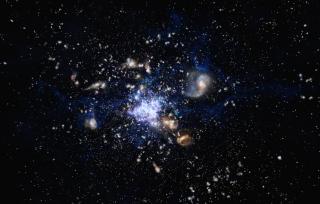Bibcode
Puglisi, Annagrazia; Daddi, Emanuele; Brusa, Marcella; Bournaud, Frederic; Fensch, Jeremy; Liu, Daizhong; Delvecchio, Ivan; Calabrò, Antonello; Circosta, Chiara; Valentino, Francesco; Perna, Michele; Jin, Shuowen; Enia, Andrea; Mancini, Chiara; Rodighiero, Giulia
Referencia bibliográfica
Nature Astronomy
Fecha de publicación:
0
2021
Número de citas
15
Número de citas referidas
14
Descripción
Feedback-driven winds from star formation or active galactic nuclei might be a relevant channel for the abrupt quenching of star formation in massive galaxies. However, both observations and simulations support the idea that these processes are non-conflictingly co-evolving and self-regulating. Furthermore, evidence of disruptive events that are capable of fast quenching is rare, and constraints on their statistical prevalence are lacking. Here we present a massive starburst galaxy at redshift z = 1.4, which is ejecting 46 ± 13% of its molecular gas mass at a startling rate of ≳10,000 M⊙ yr‒1. A broad component that is red-shifted from the galaxy emission is detected in four (low and high J) CO and [C I] transitions and in the ionized phase, which ensures a robust estimate of the expelled gas mass. The implied statistics suggest that similar events are potentially a major star-formation quenching channel. However, our observations provide compelling evidence that this is not a feedback-driven wind, but rather material from a merger that has been probably tidally ejected. This finding challenges some literature studies in which the role of feedback-driven winds might be overstated.
Proyectos relacionados

Gas Molecular y Polvo en Galacias através del Tiempo Cósmico
Dos cuestiones fundamentales en la Astrofísica son la conversión de gas molecuar en estrellas y cómo este proceso físico depende del entorno en todas las escalas, desde sistemas planetarios, cúmulos estelares, galaxias hasta cúmulos de galaxias. El objectivo principal de este proyecto es el de estudiar la formación y evolución de galaxias a partir
Helmut
Dannerbauer